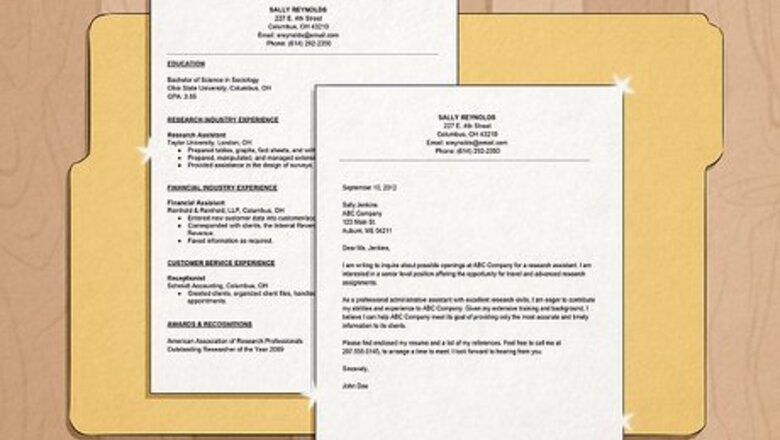
views
X
Trustworthy Source
US Citizenship and Immigration Services
U.S. government agency in charge of the naturalization and immigration systems
Go to source
- Create an American-style résumé, cover letter, and apply for jobs online. Then, ask your new employer to sponsor you and file for your work Visa.
- Gather your passport, travel itinerary, and résumé to apply for your visa on the U.S Department of State’s website
- Ask your employer to fill out an immigration petition for you. Then, fill out Form I-485 online and submit it to USCIS.
Finding a Sponsor

Create an American-style résumé and cover letter. If you deliver an American-style résumé and cover letter, the employer knows you've done your research on how to get a job in the US and that you'll have less difficulty transitioning to an American work environment. Here are some tips: Provide specific facts and figures for your educational or employment accomplishments Only include work experience that is directly relevant to the position you're applying to Use simple and consistent fonts and formatting Be specific about your English language proficiency

Search for American employers in your industry. The internet is the biggest source of information for job-seekers in America, so you're in luck! You can access the largest job search websites, such as Indeed and Monster, no matter where in the world you currently live. Set up an account on LinkedIn (if you don't already have one). Many employers use your LinkedIn profile as your résumé, especially if you're also applying online. If a company has hired people from your home country before, they're more likely to do so again. Network with colleagues from your country who now work in the US and find out what companies they work for. If you don't know people who meet this description personally, try searching for them on LinkedIn and send messages to people you find.

Contact a recruiting agency if you're an experienced professional. Private recruiters, also known as "headhunters," help companies find executive-level and other highly qualified employees, such as high-level managers and company officers. If you have 5-10 years experience in an executive or professional role (such as a lawyer or accountant), you might find it easier to work through a recruiter. Watch out for scam employment agencies that claim they can find you a job in the US. Never pay an upfront fee to an employment agency.

Edit your cover letter and résumé for each job you apply to. Read each job listing carefully and include specific skills mentioned in the listing in your résumé and cover letter. Remove skills or experience that isn't related to that particular job. Look at your cover letter and résumé as marketing tools. You're essentially selling your services to the employer. Show them that they need you on their team. Research each employer thoroughly and use information from your research in your cover letter. This tells the employer that you have an understanding of their business.

Follow up on your applications after a week or two. Many employers in the US simply don't reply to applications. Be ready to call the company to follow up on your application — and you may have to call more than once! If you're persistent, the company might decide to interview you. Schedule your follow-up calls or emails starting 1 week after you submit your application. After that, follow up again based on the response you got the first time you followed up. For example, if the employer tells you that someone will be in touch with you in 3 days and you don't hear anything in that time, call back on the 4th day. Even if you're not getting any responses to your attempts to follow up on your application, don't call or email an employer more than once a week. If you don't get anything after a month, it's usually best to quit pursuing them.

Attend your interview in person or online. If you're outside the country, any potential employer will likely set up an interview online or over the phone. They're usually not going to fly you in for an in-person interview, unless you're applying for a high-level or executive position. Even if you're interviewing online, dress as you would if you were meeting in person. Try to find a professional-looking place (even if it's just in front of a blank wall) where you can speak without interruption. Research the company before the interview and write down 2-3 questions to ask your interviewer about the company based on your research. If English isn't your first language, you might want to rehearse with someone before your interview so you have some statements prepared. Be ready to discuss your relevant skills and experiences and describe your professional accomplishments.

Ask about sponsorship when you accept the job offer. If an employer extends an offer, congratulations! Unfortunately, that's only half the battle. Now that you have an offer of employment, you need a visa to come and work in America. Smaller companies who don't frequently hire international employees might not know what they need to do to get you into the country, so be prepared to help them make sense of the process. Here are some things you can do: Tell your employer they need to file a petition for you to come to America. Point to the forms and instructions on the USCIS website. Provide your employer information about your passport, citizenship status.
Applying for a Temporary Work Visa

Ask your American employer to file a petition on your behalf. Typically, you'll need to already have a job before you apply for a nonimmigrant visa to work in the US temporarily. The employer who extended you a job offer is responsible for filing a petition with USCIS so you'll be eligible for a visa. Some categories require labor certification or approval from the US Department of Labor. The categories that require certification are listed in the instructions for the petition. There are a few categories of temporary non-immigrant work visas that will allow you to come and work in the US without an employer petition. To qualify for a visa in these categories, you generally need to be involved in international trade or investment. As of 2020, professionals who are citizens of either Mexico or Canada do not need a petition to work in the US temporarily.

Wait until your employer's petition is approved. USCIS will send your employer a notice of action when their petition is approved. Once they receive this notice, you can apply for a visa. If you apply for a visa before the petition is approved, your application will be denied and you'll have to file it again after the petition is approved. Some categories of temporary workers are limited, with only a set number of visas being issued each year. Depending on the time of year when your employer files the petition and the number of applicants already waiting, it could be several years before the petition is approved.
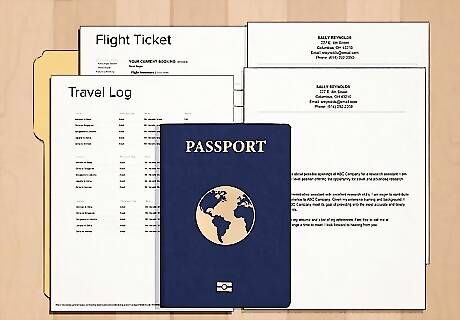
Get together the documents you'll need to complete your application. You'll need to copy some of the information from your documents onto your application, so you should keep them handy. Although you can always save your application and return to it later, it's usually easier to just complete it all at once. At a minimum, you'll need the following documents: Your valid passport Your travel itinerary, if you've already made travel plans or booked a flight Your résumé or curriculum vitae (for information about your education and work history) The dates of your last 5 visits to the US, if you've previously visited the country, as well as your international travel history in the past 5 years
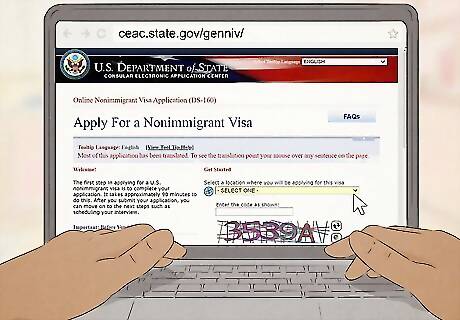
Complete your visa application online. Go to https://ceac.state.gov/genniv/ to start your application online. There's no way to set up an account, so write down the application ID number at the top right-hand corner of the page when you start your application. If you lose your connection or have to stop before you're done, you'll need that number to access your application and finish it. The DS-160 nonimmigrant visa application requires you to provide information about yourself, including your education and work history and your criminal background. All of your answers must be written in English. If you don't feel that your English is strong enough to answer all the questions, you can get someone to help you.

Upload a recent passport-sized photo for your application. Go to a professional passport photographer to have your photo taken in front of a white background. Ask them for a digital copy of the photo that you can upload. If digital photos aren't available, you can also scan a print. Digital images must be square, a minimum of 600 x 600 pixels and a maximum of 1200 x 1200 pixels. Make sure it's in JPEG format and no larger than 240 kb.
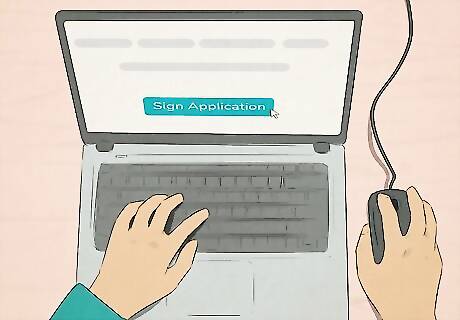
Submit your online application. Click the "Sign Application" button to submit your application electronically. The website will give you one last opportunity to check over all of your answers and make sure they're complete and correct. When you're done with this check, click the button to submit your application. The website will display a confirmation page with a barcode. Print this page and keep it in a safe place — you'll need it for your interview at your local US embassy or consulate.

Contact the US embassy or consulate nearest you. Go to https://www.usembassy.gov/ and enter the name of your country to get contact information for US embassies and consulates. Call or write to the one closest to you and tell them that you are applying for a nonimmigrant temporary work visa. Ask if you need to be interviewed by a consular officer. If you do, they'll schedule a time for you to come in for your interview. You'll also get information about the local embassy or consulate when you submit your online application. Check the website for any local rules regarding interviews that are specific to that location. The consular officer you speak with will also likely go over these rules with you.

Participate in your visa interview. A consular officer will ask you questions about your application to determine if you're qualified to receive a visa. Answer all of their questions completely and honestly. At your interview, you can expect to: Review your original documents Pay your $190 visa application fee Get your fingerprints taken Find out whether your application has been approved or requires further processing
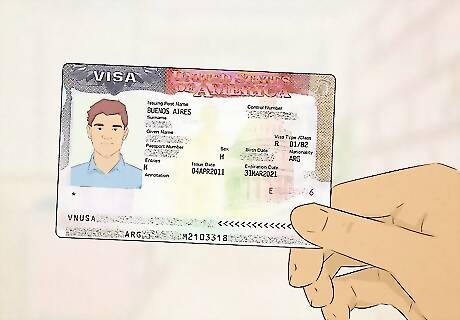
Pick up your visa at the embassy or consulate. The consular officer will let you know when your passport and visa will be available for you to pick up. If you had to travel a long distance to the embassy or consulate, they may arrange for a courier to deliver your passport and visa to you so you don't have to make that trip again. You may have to pay an additional fee when your visa is issued. These fees depend on your country of citizenship. The consular officer will let you know if you have to pay a fee and how much it is.
Getting a Green Card

Ask your employer to file an immigration petition for you. Your employer's petition, Form I-140, sets you on the path toward permanent residency. Once you become a permanent resident, you won't risk losing your status in the US if you don't return to your home country or work continuously for the same employer. Some petitions may also require certification from the US Department of Labor (DOL). If your employer doesn't have a lot of international employees, they might not be well-versed in this process. In that situation, it's a good idea to talk to an attorney who specializes in immigration law — many of them give free initial consultations. They can help walk you through the process so you can explain to your employer what you need from them.

Find out your priority date from your employer. Your priority date is usually the date your employer filed the immigration petition for you. However, if your petition required DOL certification, your priority date is the date when USCIS receives that certification. Your employer typically will get a notice from USCIS that includes your priority date. Your priority date determines when you can file your application to become a permanent resident. If you file your application too early, USCIS will reject it and you'll have to do the whole thing all over again.
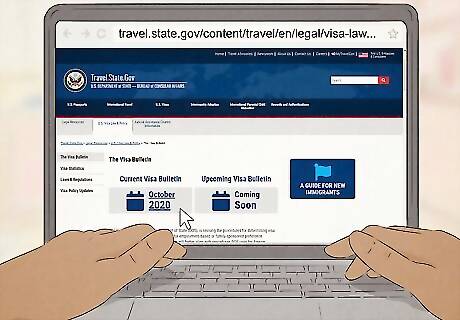
Use the filing chart to determine when you can file your application. Go to https://travel.state.gov/content/travel/en/legal/visa-law0/visa-bulletin.html to access the most recent visa bulletin. On the chart, find your visa type in the first column on the left-hand side of the chart. Then, move to the right on the same row until you find a date listed under the name of your home country. If your priority date is earlier than the date listed, you can also file your application. However, if your priority date is after the date listed, you'll have to wait at least until that date before you can file your application. If there is a "C" instead of a date, that means applications are currently being accepted.

Get a medical examination from an approved civil surgeon. Go to https://my.uscis.gov/findadoctor to find a doctor near you. The doctor will examine you and complete a form for you to submit with your green card application. You'll get a copy for your records as well as a copy in a sealed envelope to submit to the USCIS. The civil surgeon's role is to make sure you don't have a communicable disease that could endanger the public health or a physical or mental disorder associated with harmful behavior. They'll also make sure you have proof of all required vaccinations and give you vaccinations as needed. Depending on the results of your examination, the civil surgeon might refer you to another doctor for follow-up treatment. Not arranging for follow-up treatment could result in denial of your green card application. If you show signs of drug addiction or abuse, you will likely not be eligible for a green card.
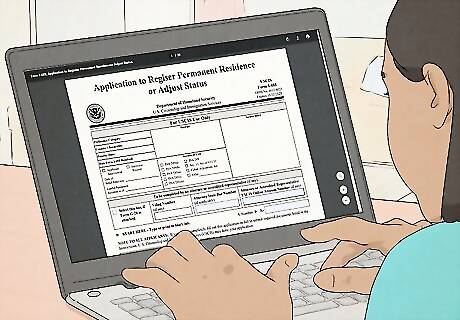
Fill out Form I-485 to apply for a green card. Download your form at https://www.uscis.gov/i-485. Type your answers directly on the form on your computer or print out the form and write your answers legibly using a black pen. Answer each question honestly and completely — there's extra space available if you need it. It's a good idea to read through the instructions before you start filling out the form. If there's anything you don't understand, you might want to talk to an attorney who specializes in immigration law.
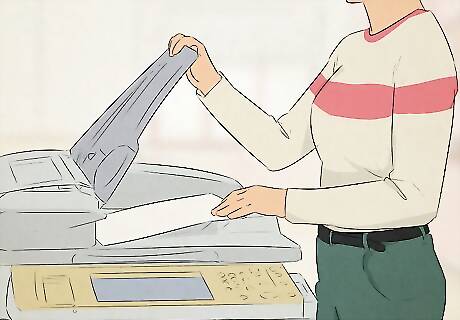
Make copies of documents to support your application. USCIS requires copies of official documents to back up most of the statements you make on your application. You don't have to send originals, but you may need to take the originals with you if USCIS schedules an interview. At a minimum, you'll need copies of the following documents: 2 passport-sized photos of yourself taken in the last 6 months The front and back of a valid, government-issued photo ID Your birth certificate Passport page with admission or parole stamp and nonimmigrant visa Arrival-departure record Medical exam report and vaccination record Certified police record and court records of any criminal charges, arrests, or convictions
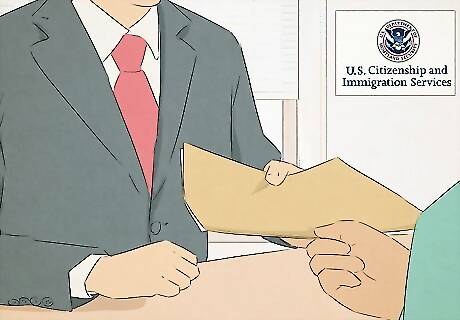
Submit your application and supporting documents to USCIS. Go to https://www.uscis.gov/i-485 to find out where to submit your application and supporting documents. You can also get this information by calling the USCIS National Customer Service Center at 1-800-375-5283 (TTY 1-800-767-1833). Include a check or money order for your filing fee. As of 2020, fees for Form I-485 total $1225. This includes a filing fee of $1,140 and a biometric services fee of $85. Make checks or money orders payable to "U.S. Department of Homeland Security."
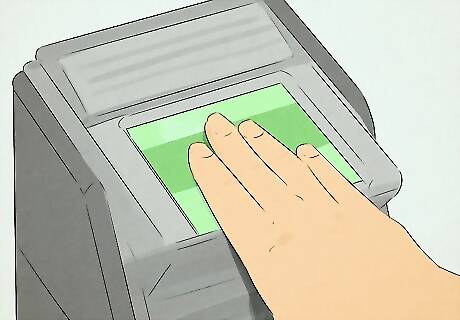
Go to your biometric services appointment. After USCIS receives your application, they'll send you a notice with the date, time, and location of your biometric services appointment. The appointment will be scheduled at an application support center (ASC) near you. Bring your appointment notice and a valid, government-issued photo ID with you to your appointment. At the appointment, a USCIS officer will take your fingerprints and get your signature. If you didn't submit photos with your application, or if your photos weren't acceptable, you'll also get your photo made at this time.

Participate in an interview if you receive a notice. Interviews aren't always required. However, if USCIS decides you need one, they'll send you a notice with the date, time, and location. If you won't be able to attend on that date, call USCIS at the number on the notice as soon as possible to get it changed. Your notice will tell you what you need to bring with you to your interview. Usually, you need to bring originals of all the copies of supporting documents that you submitted with your application. At the interview, a USCIS officer will ask you questions about the information on your application. Your answers are under oath, so answer completely and honestly. If you don't understand a question, ask the officer for clarification.
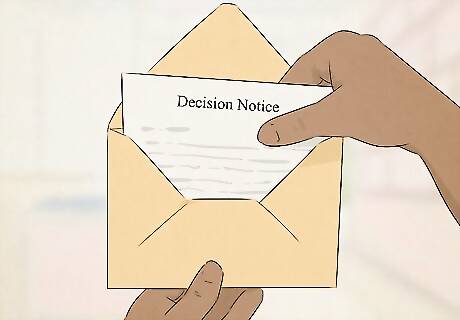
Wait to receive your written decision notice. It may take several months to find out USCIS's decision on your application. If your application was accepted, you'll get an approval letter first, then get your actual green card a few weeks later. If USCIS denies your application, the notice will explain the reason why and what you can do if you want to appeal that decision. If more documentation or information is needed to process your application, USCIS will send you a notice. Provide the requested documentation by the date listed on the notice or your application will be denied. Contact USCIS if you have difficulty getting any of the requested documents by the deadline. In the meantime, you can check the status of your application through your USCIS online account or by calling the USCIS Contact Center at 1-800-375-5283.


















Comments
0 comment